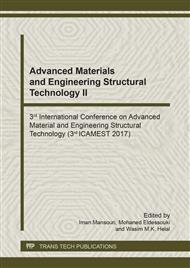[1]
F. Sadeghi, B. Jalalahmadi, T. S. Slack, et al. , A Review of Rolling Contact Fatigue, J. Tribol. 131 (2009) 041403.
Google Scholar
[2]
M. N. Kotzalas, T. A. Harris, Fatigue Failure Progression in Ball Bearings, J. Tribol. 123 (2001) 238-242.
DOI: 10.1115/1.1308013
Google Scholar
[3]
E. Bormetti, G. Donzella, A. Mazzu, Surface and Subsurface Cracks in Rolling Contact Fatigue of Hardened Components, Tribol. T. 45 (2002) 274-283.
DOI: 10.1080/10402000208982550
Google Scholar
[4]
A. Tjernberg, Fatigue lives for induction hardened shafts with subsurface crack initiation, Eng. Fail. Anal. 9 (2002) 45-61.
DOI: 10.1016/s1350-6307(00)00036-4
Google Scholar
[5]
J. L. Cunningham, D. J Medlin, G. Krauss, Effects of induction hardening and prior cold work on a microalloyed medium carbon steel, J. Mater. Eng. Perform. 8 (1999) 401-408.
DOI: 10.1361/105994999770346684
Google Scholar
[6]
H. Kristoffersen, P. Vomacka, Influence of process parameters for induction hardening on residual stresses, Mater. Des. 22 (2001) 637-644.
DOI: 10.1016/s0261-3069(01)00033-4
Google Scholar
[7]
J. D. Almer, J. B. Cohen, R. A. Winholtz, The effects of residual macrostresses and microstresses on fatigue crack propagation, Metall. Mater. Trans. A, 29 (1998) 2127-2136.
DOI: 10.1007/s11661-998-0038-9
Google Scholar
[8]
G. A. Webster, A. N. Ezeilo, Residual stress distributions and their influence on fatigue lifetimes, Int. J. Fatig. 23 (2001) 375-383.
DOI: 10.1016/s0142-1123(01)00133-5
Google Scholar
[9]
M. A. Moshier, B. M. Hillberry, The inclusion of compressive residual stress effects in crack growth modelling, Fatig. Fract. Eng. M. 22 (1999) 519-526.
DOI: 10.1046/j.1460-2695.1999.00182.x
Google Scholar
[10]
H. Wang, F. G. Buchholz, H. A. Richard, et al., Numerical and experimental analysis of residual stresses for fatigue crack growth, Comp. Mater. Sci. 16 (1999) 104-112.
DOI: 10.1016/s0927-0256(99)00052-x
Google Scholar
[11]
L. F. Xia, Heat treatment technology of metals, third ed., Harbin, (2008).
Google Scholar
[12]
D. H. Xu, Z. B. Kuang, A study on the distribution of residual stress due to surface induction hardening, J. Eng. Mater. T. ASME. 118 (1996) 571-575.
DOI: 10.1115/1.2805958
Google Scholar
[13]
W. Q. Meeker, M. J. LuValle, An accelerated life test model based on reliability kinetics, Technometrics, 37 (1995) 133-146.
DOI: 10.1080/00401706.1995.10484298
Google Scholar
[14]
G. B. Yang, Optimum constant-stress accelerated life-test plans, IEEE T. Reliab. 43 (1994) 575-581.
DOI: 10.1109/24.370223
Google Scholar
[15]
W. B. Zhao, E. A. Elsayed, A general accelerated life model for step-stress testing, IIE Trans. 37 (2005) 1059-1069.
DOI: 10.1080/07408170500232396
Google Scholar
[16]
I. H. Khamis, J. J. Higgins, A new model for step-stress testing, IEEE T. Reliab. 47 (1998) 131-134.
Google Scholar
[17]
Z. Lin, H. Fei, A nonparametric approach to progressive stress accelerated life testing, IEEE T. Reliab. 40 (1991) 173-176.
DOI: 10.1109/24.87123
Google Scholar
[18]
Z. Q. Pan, N. Balakrishnan, Q. Sun, Bivariate constant-stress accelerated degradation model and inference, Commun. Stat-Simul. C. 40 (2011) 247-257.
DOI: 10.1080/03610918.2010.534227
Google Scholar
[19]
C. S. Whitman, Accelerated life test calculations using the method of maximum likelihood: an improvement over least squares, Microelectron. Reliab. 43 (2003) 859-864.
DOI: 10.1016/s0026-2714(03)00071-4
Google Scholar
[20]
C. M. Kim, D. S. Bai, Analyses of accelerated life test data under two failure modes, Int. J. Relia. 9 (2002) 111-125.
Google Scholar
[21]
W. D. Wang, D. B. Kececioglu, Fitting the Weibull log-linear model to accelerated life-test data, IEEE T. Reliab. 49 (2000) 217-223.
DOI: 10.1109/24.877341
Google Scholar


